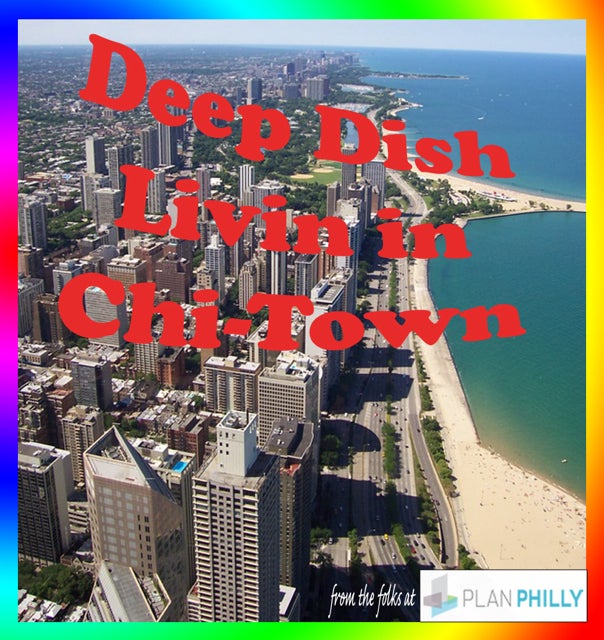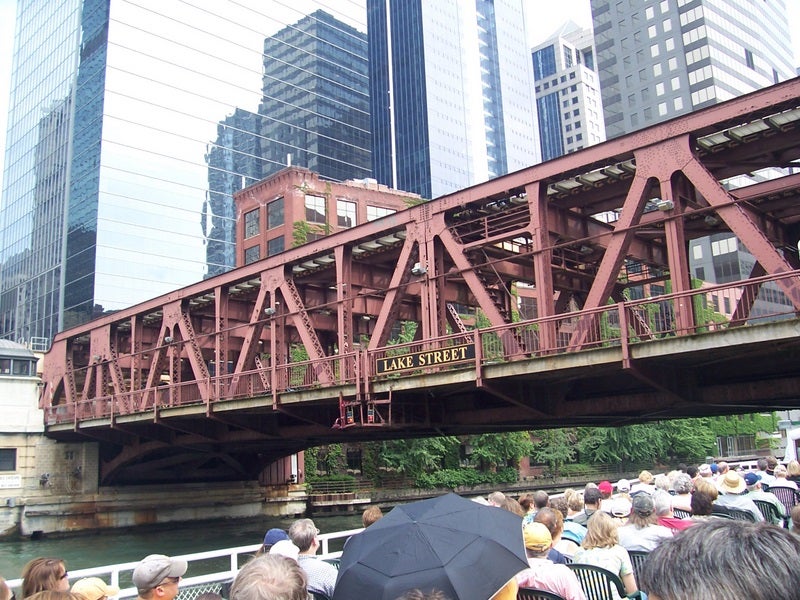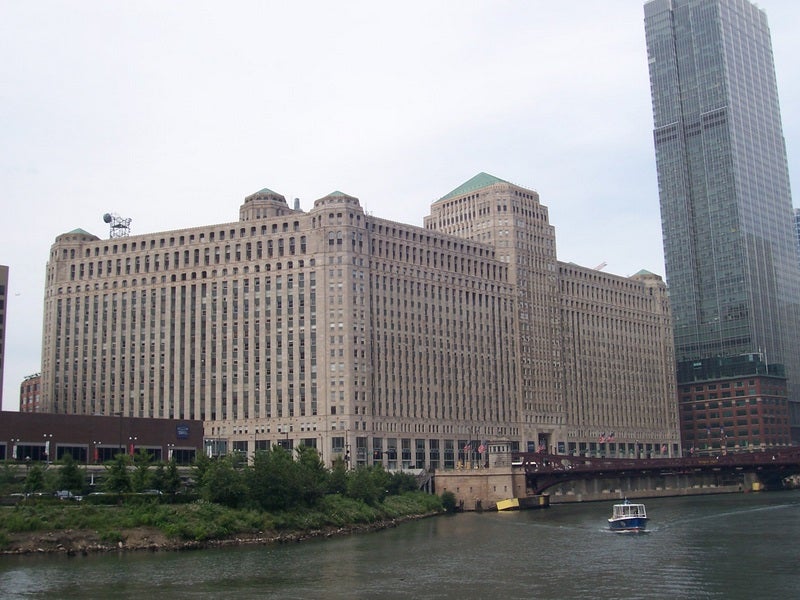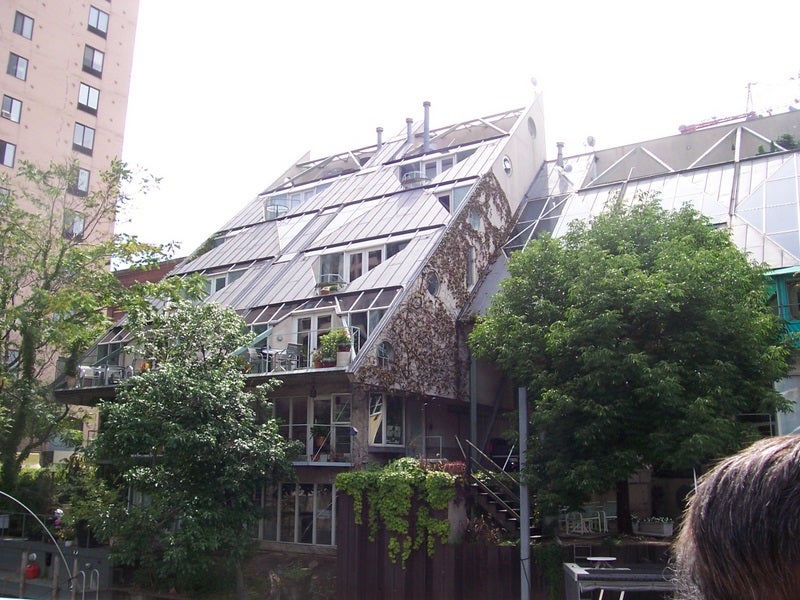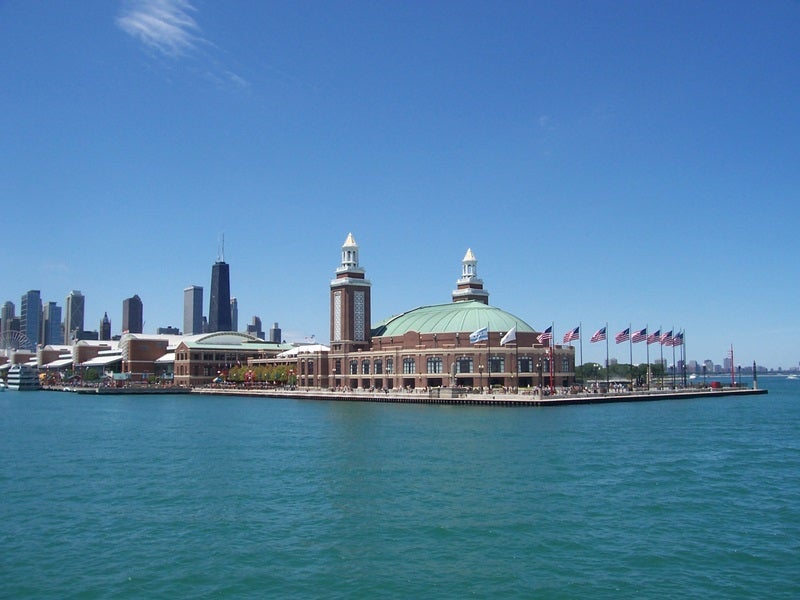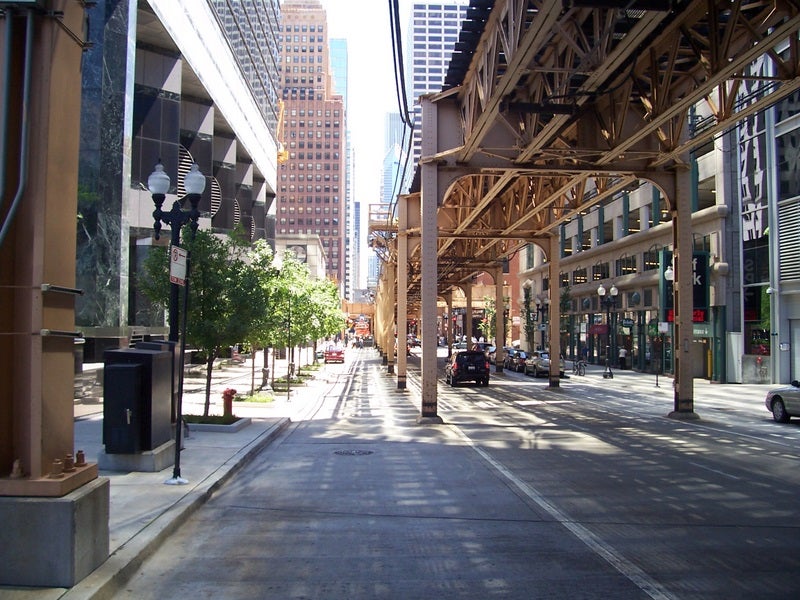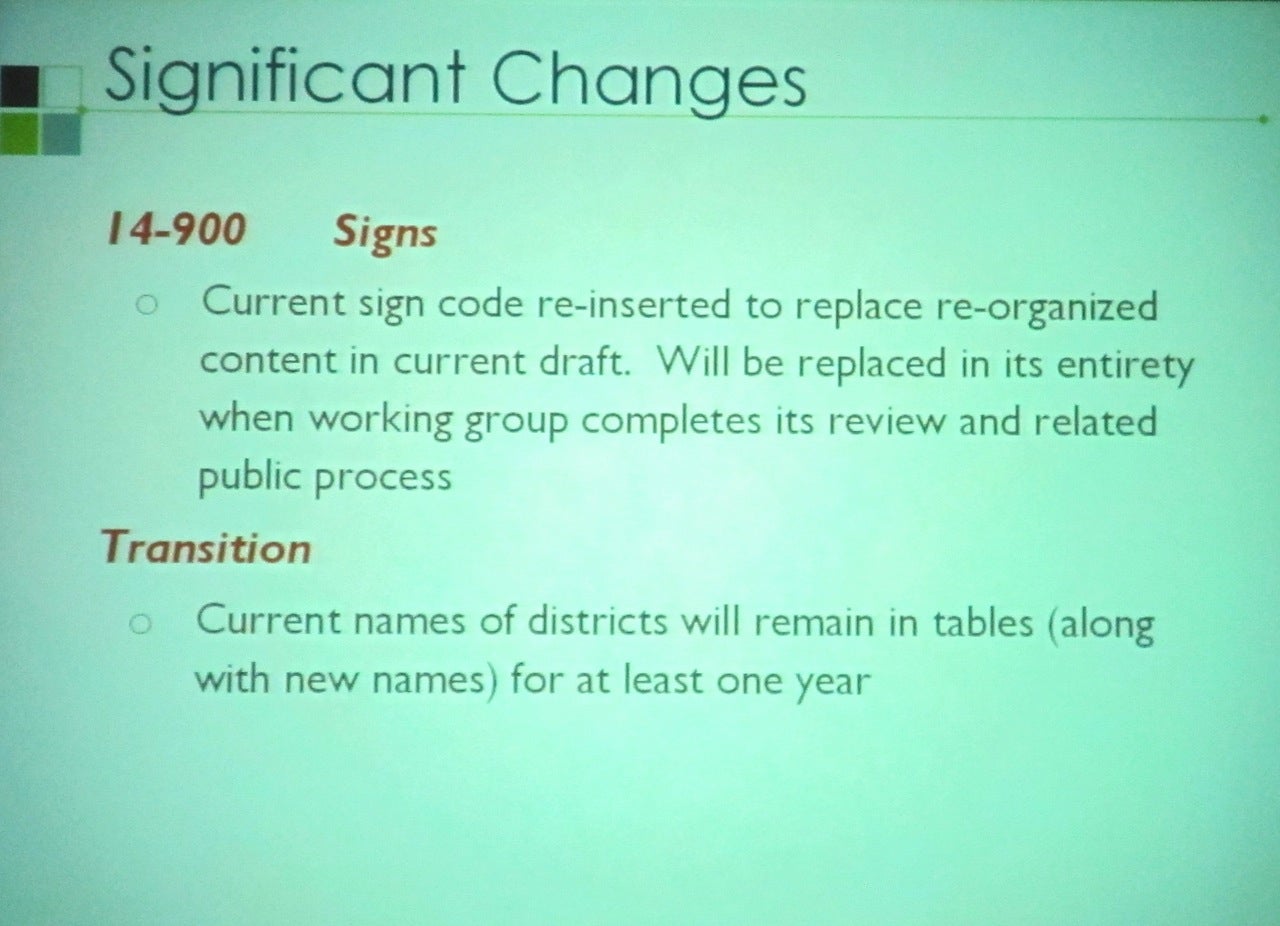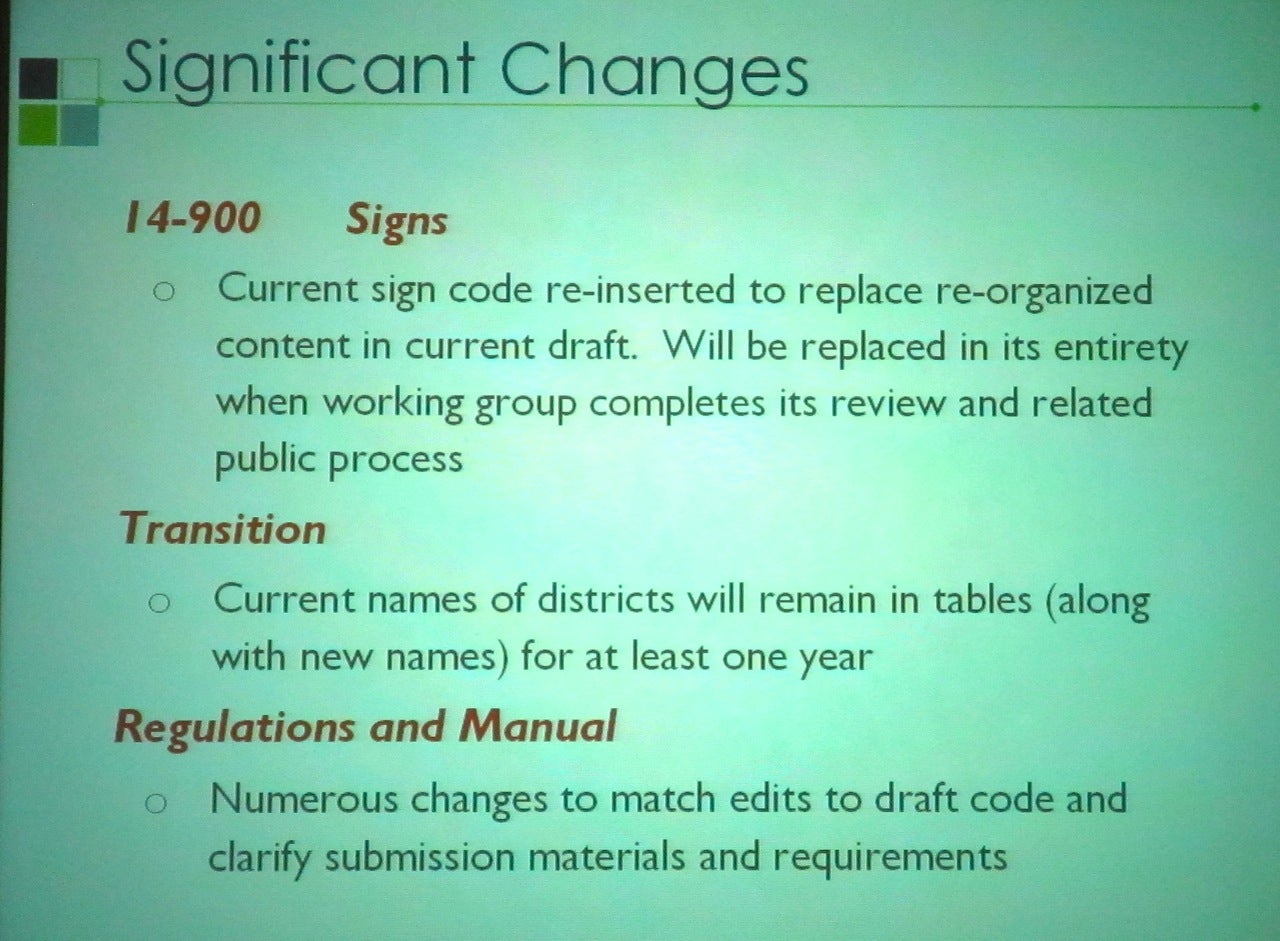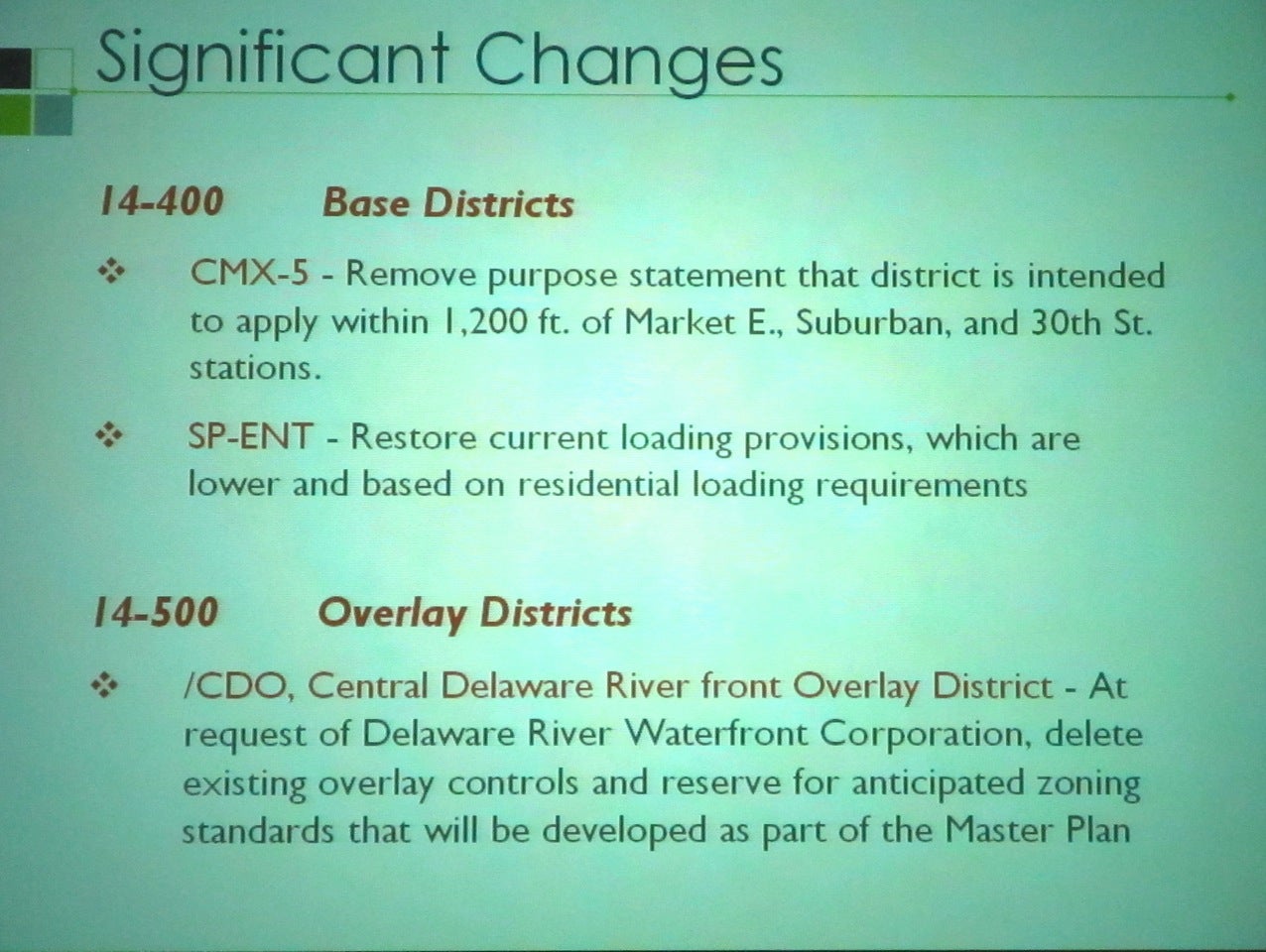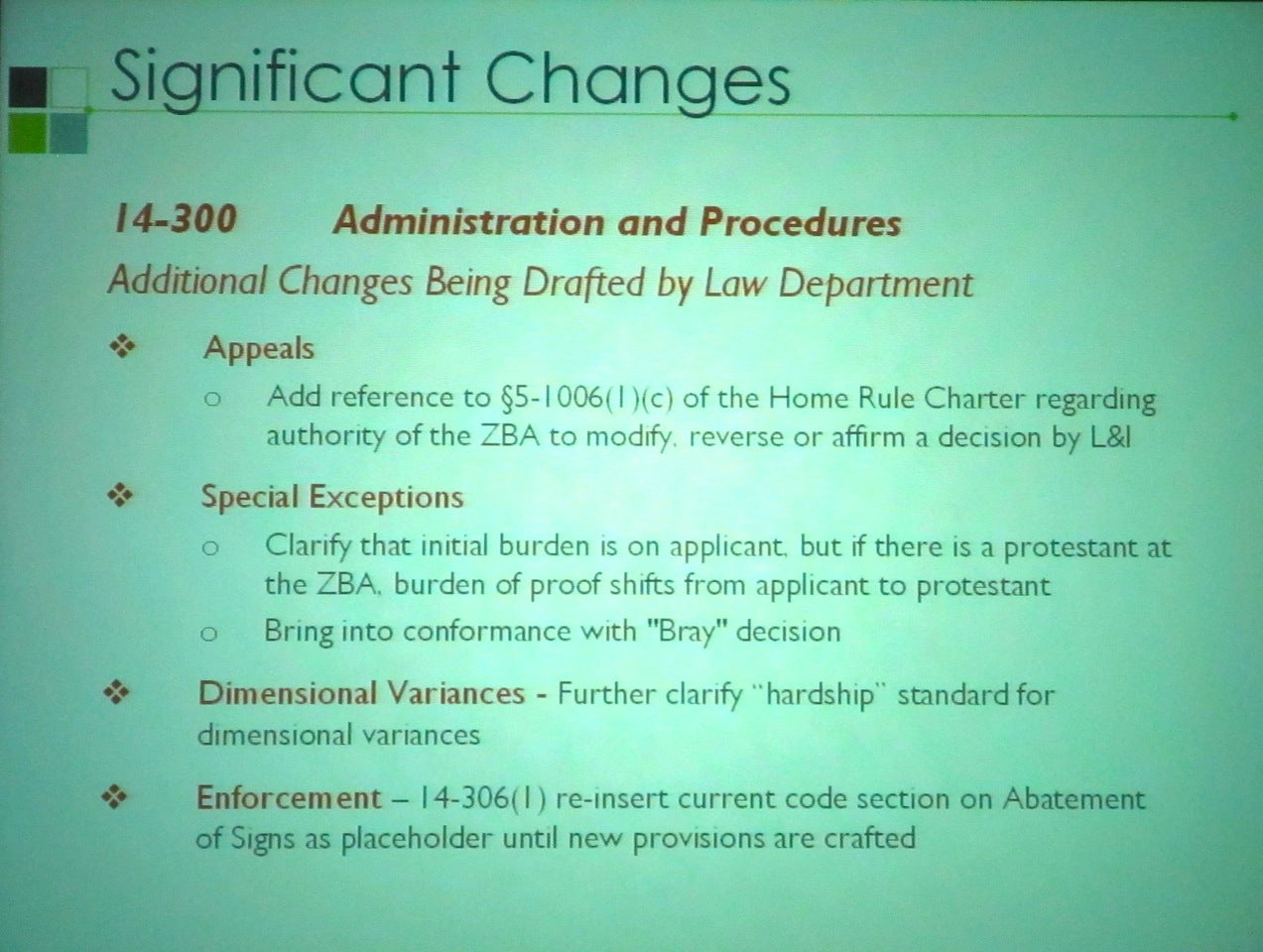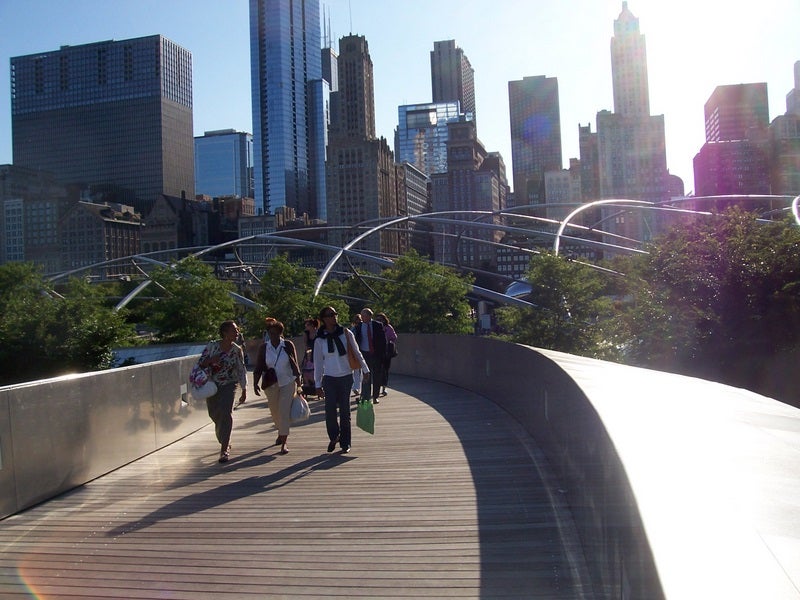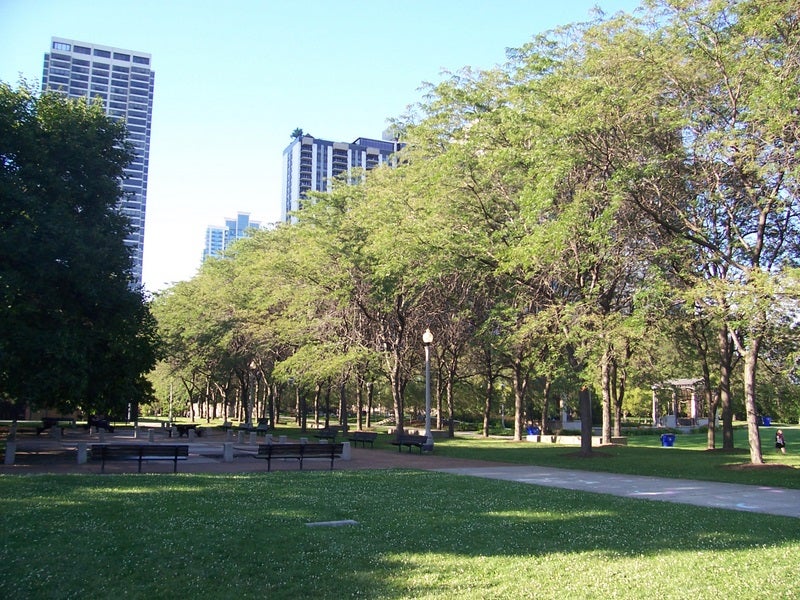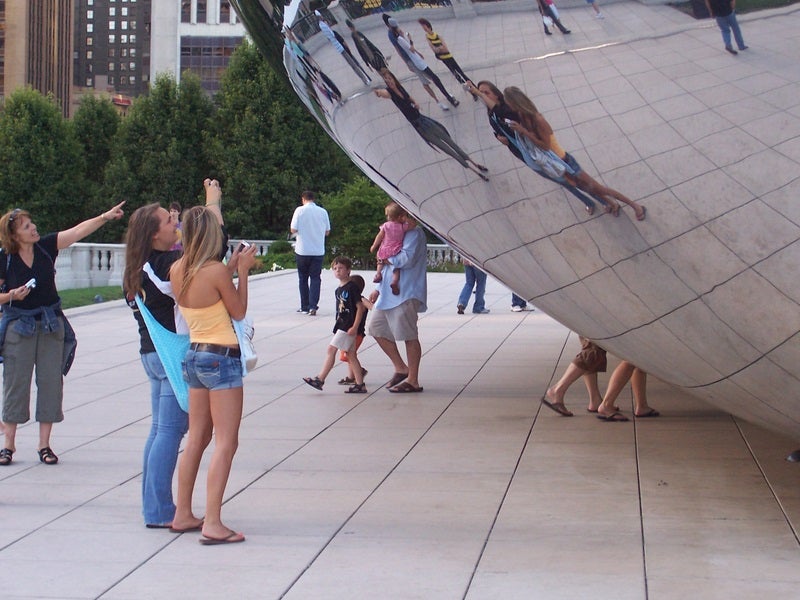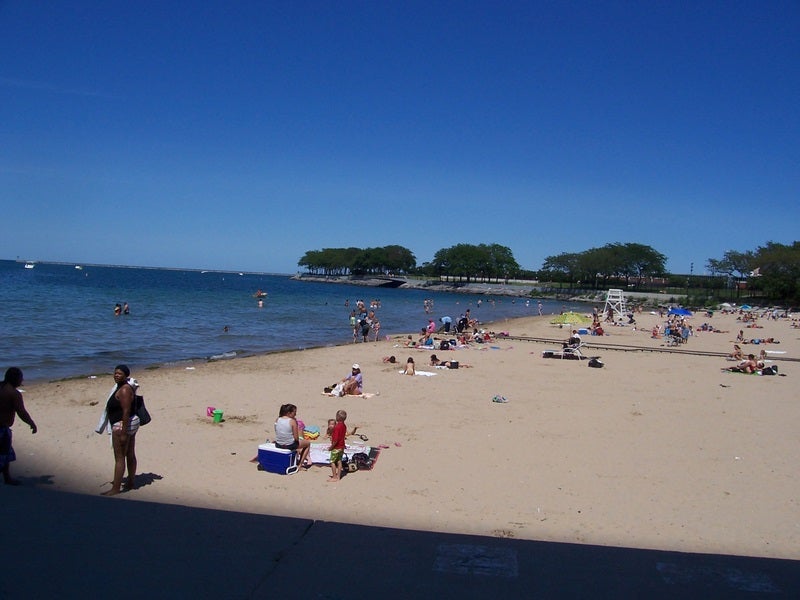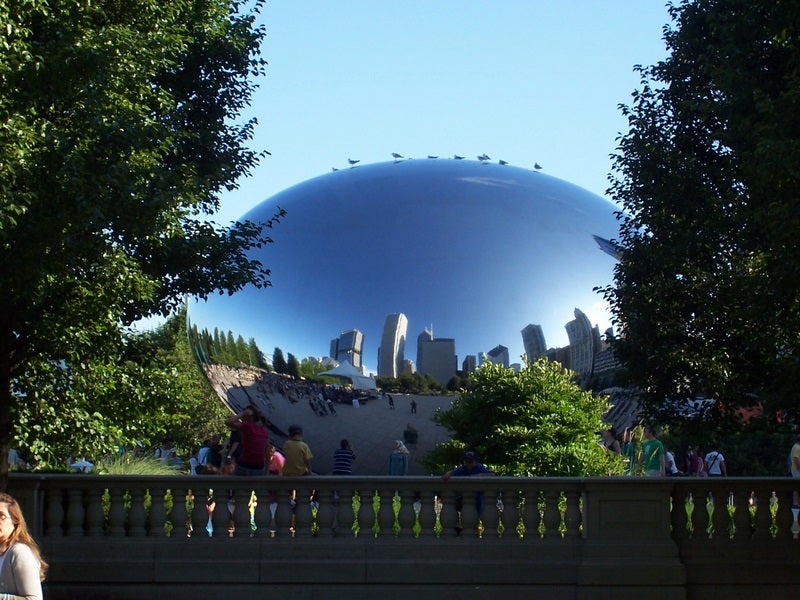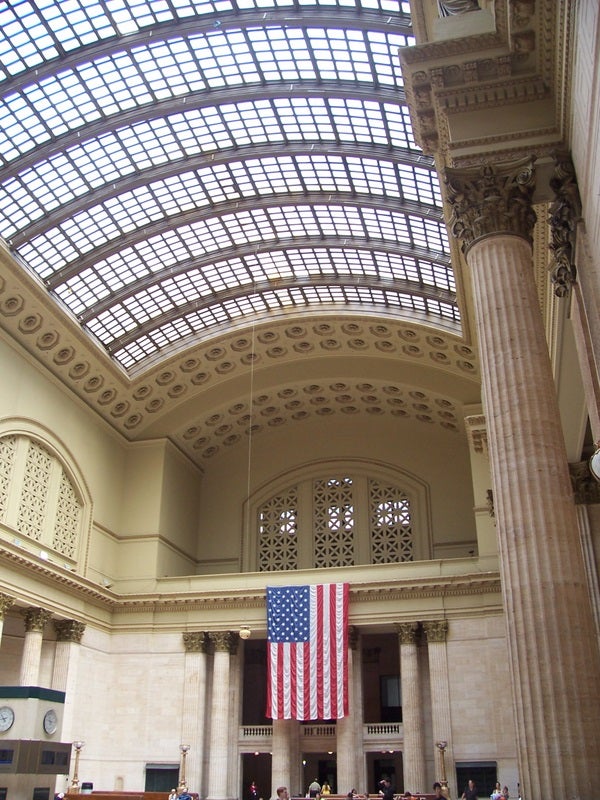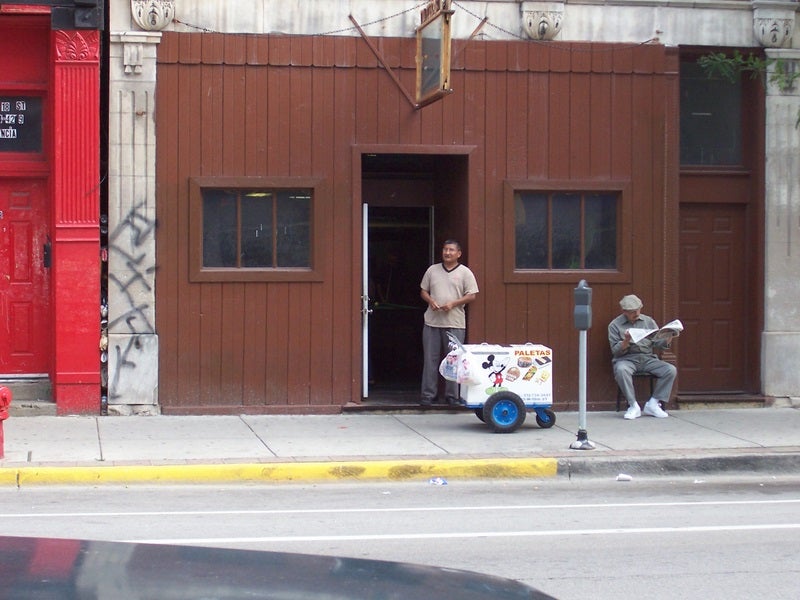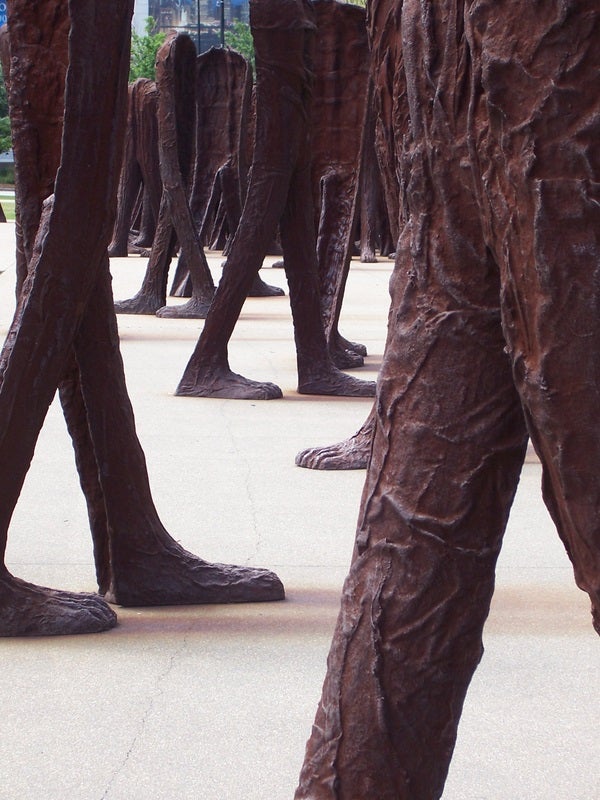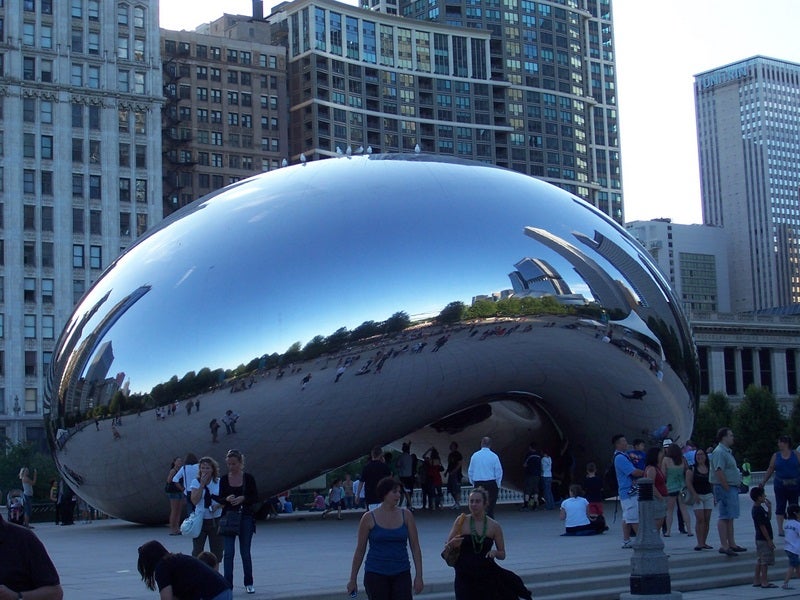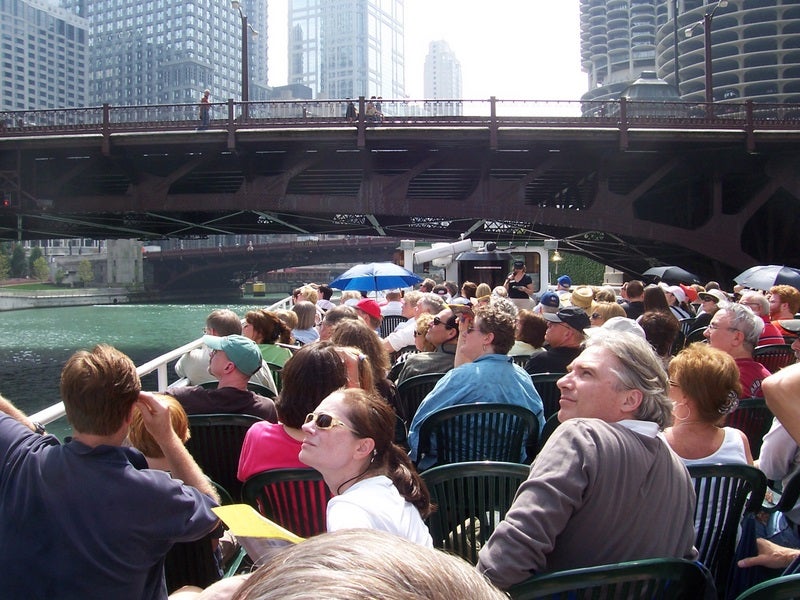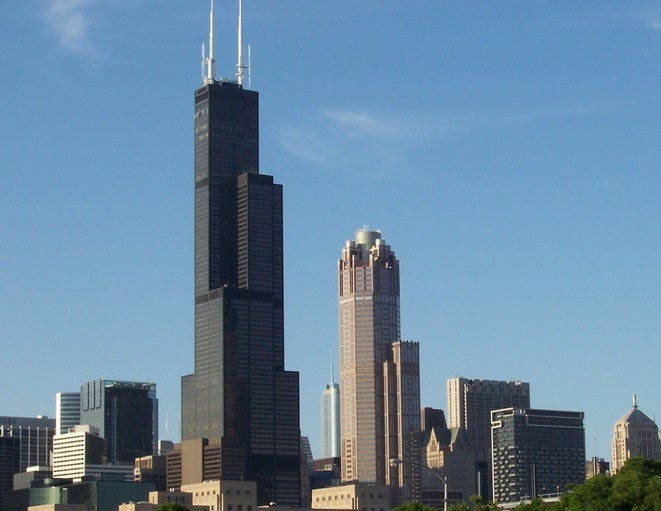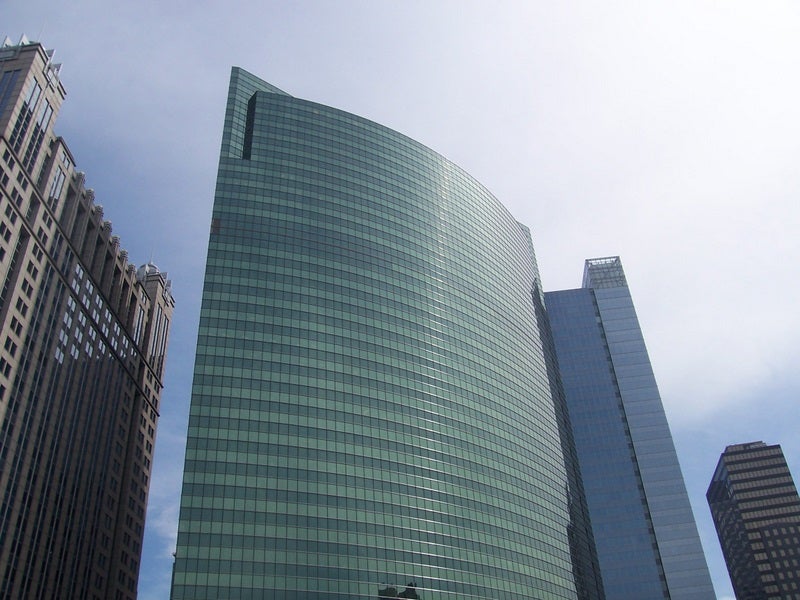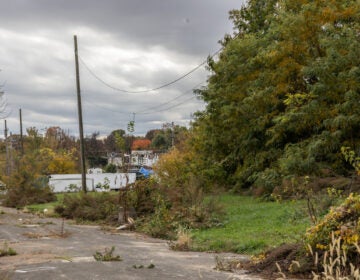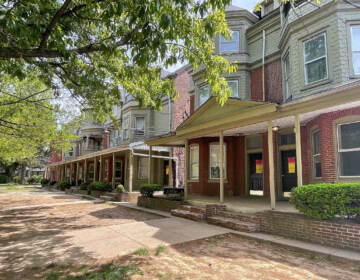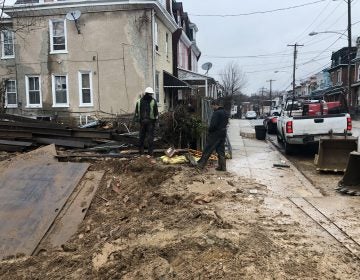Postcard from the Windy City
Previous postcards: Detroit Part 1, Austin, China, San Francisco, Germany, Pittsburgh, New Orleans, New York City, Boston, San Antonio, Minneapolis, Detroit Part 2, Templehof
CHICAGO – Chicago’s weather can be murderous: Heat waves have been known to kills hundreds, and bitter cold snaps last for months. But the Windy City in late summer can also suddenly take on the feel of an urban Lake Tahoe. Retail, museums and parks rival Paris. One can even imagine the Mediterranean in Spain from the sands of the city’s beaches.
A recent trip was a lucky one. The weather was nearly perfect, the breezes off Lake Michigan positively alpine, temperatures in the high 70s and low 80s.
That was important, because the longer you can be outside in Chicago, the better to see its landmarks, neighborhoods, stunning parks and waterways. The weather will usually inform your itinerary in this town, from taking in a game at Wrigley Field to climbing aboard a tall ship for a cruise in the lake.
But we’re guessing you know that already, and this ain’t Travelocity.
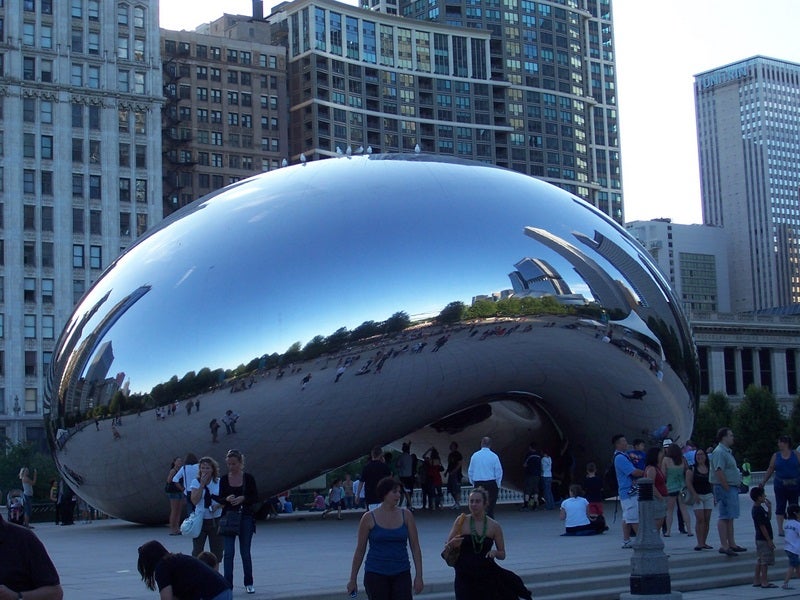
“Cloud Gate,” Millennium Park, a 110-ton elliptical work by British artist Anish Kapoor, is inspired by liquid mercury and made up of a seamless series of stainless steel plates, reflecting the skyline and anyone within its wide capture zone.
Diving into the buildings
There’s not really a whole lot to add to the dialogue about Chicago’s plans of development or its built environment for out-of-town audiences, much less planning and architectural professionals who know the town well or have studied it.
Daniel Burnham’s 100-year-old “Plan of Chicago” is the Bible, the Koran and the Book of Kells. You know about Frank Lloyd Wright and Louis Sullivan, separate or together. And the long-gone slaughterhouses, Eliot Ness and the 1893 World’s Columbian Exposition. It’s all textbook stuff – fascinating of course, but a yawner for a PlanPhilly Postcard from Chicago.
So we’ll focus here on what is near the water (lake, river, inner-city beach, etc.) and what you see from a cruise along the heavily algae-tinged, aquamarine waters of the Chicago River. Specifically, via snapshots from the deck of “Chicago’s First Lady,” a sight-seeing ferry operated expertly by the Chicago Architectural Foundation (CAF). It is really the only way to spend one’s first hours in the City of Broad Shoulders.
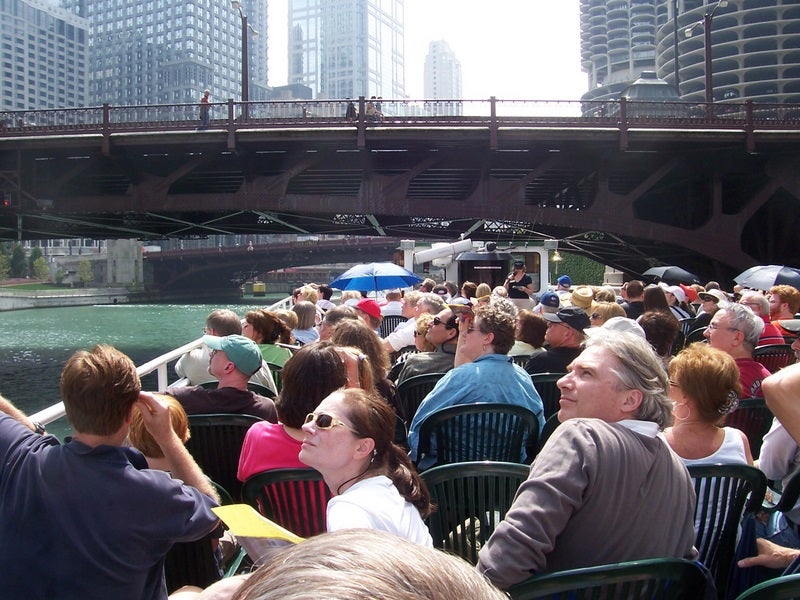
Aboard the Chicago’s First Lady.
The CAF estimates that 175,000 folks a year take these cruises (there are three ferries), staffed by volunteer docents like Marie Spicuzza, who charmed a jam-packed 3 p.m. cruise with her encyclopedic knowledge, delivered in an unmistakably cheerful mid-Western accent, tangy with Chicago colloquialisms.
Asked if she ever tires of giving the same schpiel over and over again, like a live-action PowerPoint presentation, Spicuzza was unequivocal. “No, not at all,” she said. “The buildings, the skyline – they are always changing.”
Even in recession, the story changes. That’s because, at least with Spicuzza, the ownership of the towers is touched on as well as the styles and history. In fact, Spicuzza informed the boatload of gawkers that the Sears Tower, the 110-story icon at 233 S. Wacker Drive, would soon no longer be the Sears Tower. Shortly afterward – during our visit, in fact – it officially became the Willis Tower, named for its new owner, London-based insurance giant Willis Group Holdings.
Something tells me that “Sears Tower” will hang on for quite a while, though.
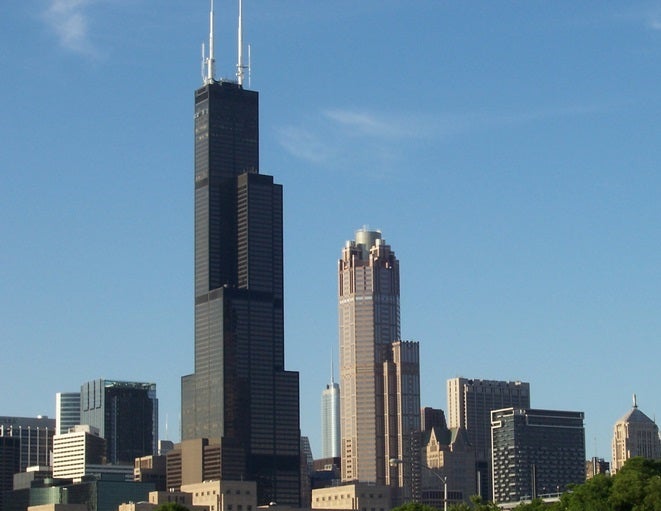
Whatyou talkin’ about, Willis? (photo of Sears tower)
The CAF cruise allows the eye, from a unique distance, to take in scores of office buildings, bridges and fountains. You marvel at clock towers, condos, even loading docks. There are river cottages, lofts and other conversions. Glorious triumphs and cringe-worthy mistakes – sometimes directly across the water from each other. Ornate bridge towers and plain, wooden drawbridge houses. The gleaming blue-tinted glass of the Swissôtel and the shimmering 333 W. Wacker Drive, or the chamfered corners and flying buttresses of the Chicago Tribune’s Gothic cathedral of the printed word.
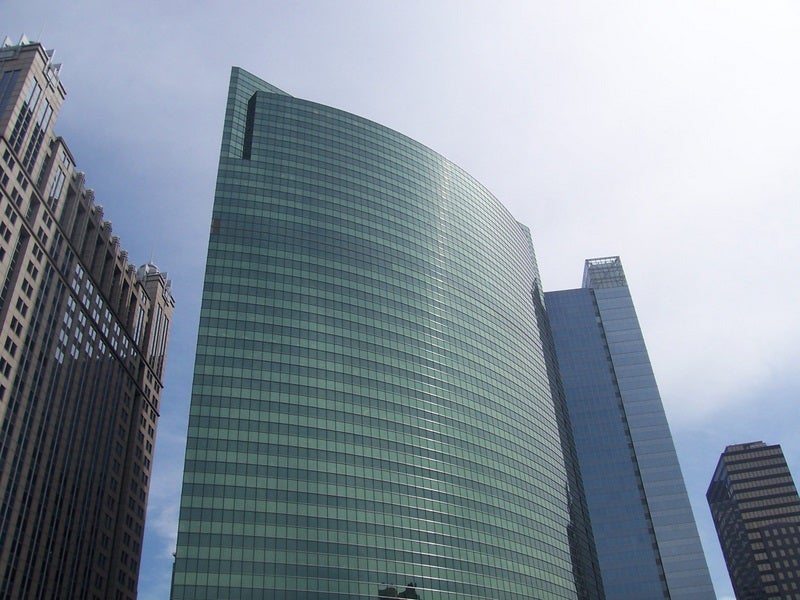
333 W. Wacker Drive
The cruise starts on the river’s Main Branch, which extends from the Navy Pier on Lake Michigan through downtown. The city’s infrastructural quirkiness is first encountered here, where engineers – in 1900 – did nothing less than reverse the river’s direction to protect the lake from the city’s mounting sewage problem and bring in clean water to the city. A massive lock was built at the mouth of the river in 1930 to regulate intake from the lake.
“That is the ultimate example of a city that prizes its waterfront, and it always has,” said Chicago native Tom Corcoran, the incoming president of the Delaware River Waterfront Corp., speaking at a recent Penn Institute for Urban Research event. “[Burnham’s plan] said that 29 miles of the waterfront will be forever open and preserved for public use.”
The river turns starboard along the North Branch, and the cruise makes a U-turn and motors down the South Branch before turning around and coming back. Perspectives change dramatically on the return trip.
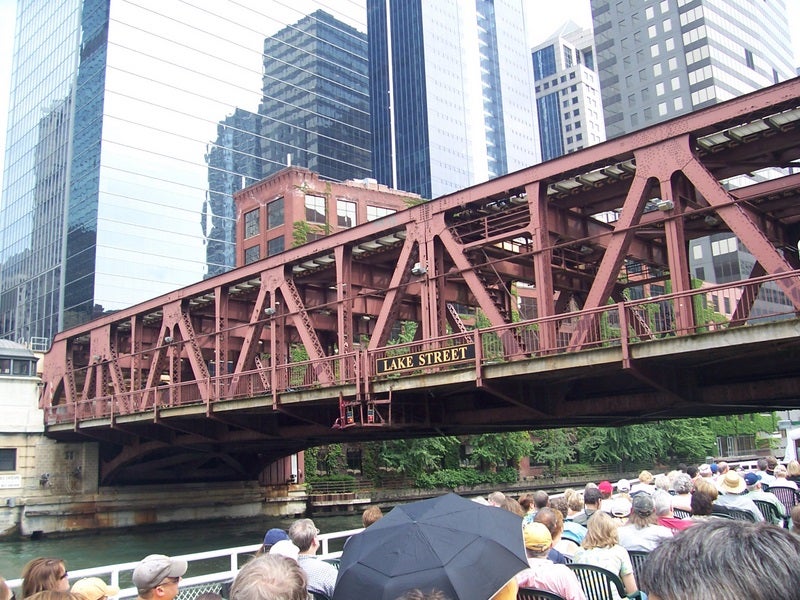
Lake Street bridge
Take the Merchandise Mart, an enormous, 4 million square-foot limestone structure that you can probably see from space. Built on the northeast intersection where the river branches, it is almost impossible to capture in a camera frame from the surface of the river, unless you’ve got a wide-angle or fisheye lens. The cruise allows you to inspect from three or four different perspectives without leaving your seat.
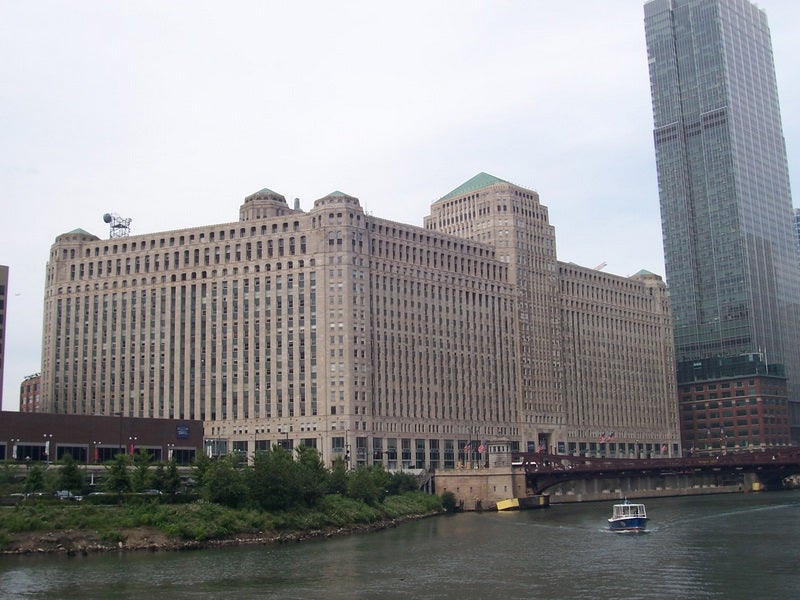
The Merchandise Mart, from about a quarter mile away
Marshall Field & Co. built the limestone behemoth just before the Great Depression, with the idea that more than a dozen Marshall Field warehouses would be consolidated within. It’s so big that, cruising by, you can become disoriented in its tremendous width, perforated with endless strips of vertical windows and streamlined Art Deco craftsmanship. It’s like six buildings merged into one.
But pay attention or you might miss the “River Cottages,” designed by Harry Weese in 1990, four townhouses that drew envious “oohs” and “ahs” from the passengers. The reason? You want to live there. You just do.
Built on a nautical theme, with each house having its own dock and porthole-like windows, the row has overwhelmingly triangular accents – like sharp-edged sails. Glass and support beams and lightly colored roofing and open decks tumble elegantly downward toward the river, with each aperture and entrance its own set piece. Spiral staircases can just barely be glimpsed as they connect to fire escapes that also mimic ships’ ladders. We learned that Chicago, like many areas of the country, has taken a beating with the mortgage meltdown, but these Weese cottages seem as close to recession-proof as a home can get. It’s a shame that directly across the water is a not-so-pleasant view: the East Bank Club, a private health club built in 1979 in a manner that suggests its architects (Ezra Gordon and Jack Levin Associates) paid no mind to its setting. There’s no evident access to the water and it doesn’t appear to provide any views of it from inside. It’s a tan, polyester leisure suit of a building.
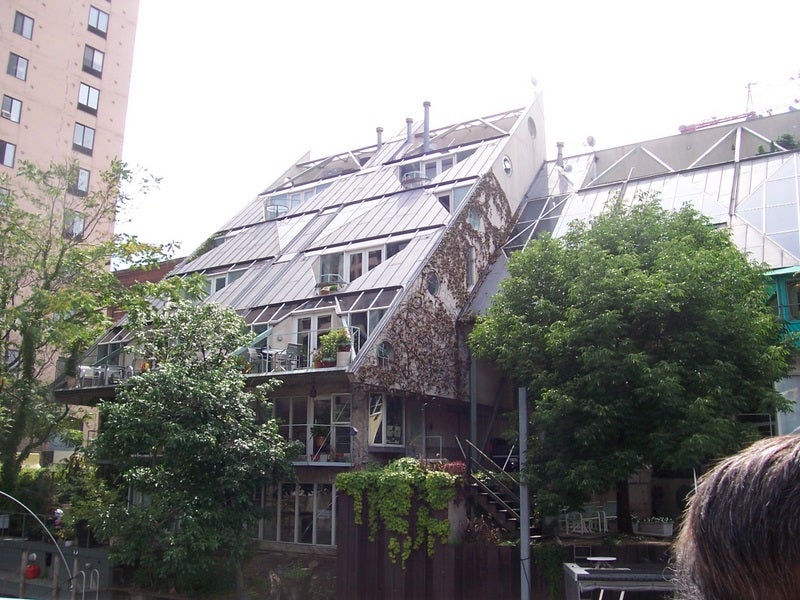
The River Cottages
Toward the end of the cruise, at the entrance to Lake Michigan, is the Navy Pier, a renovated Burnham landmark, and some old landfills that are now home to a half dozen or so condominium towers on what is known as Lakeshore East – most of them built at the height of the real estate boom of the past five years. There’s also a fair amount of cleared ground nearby, with preliminary construction work in evidence that has been put on hold indefinitely – such as the 2,000-foot baguette-shaped spire from architect Santiago Calatrava. If completed, the residential high-rise, cork-screwing itself into the ether, will exceed the Sears / Willis Tower in height.
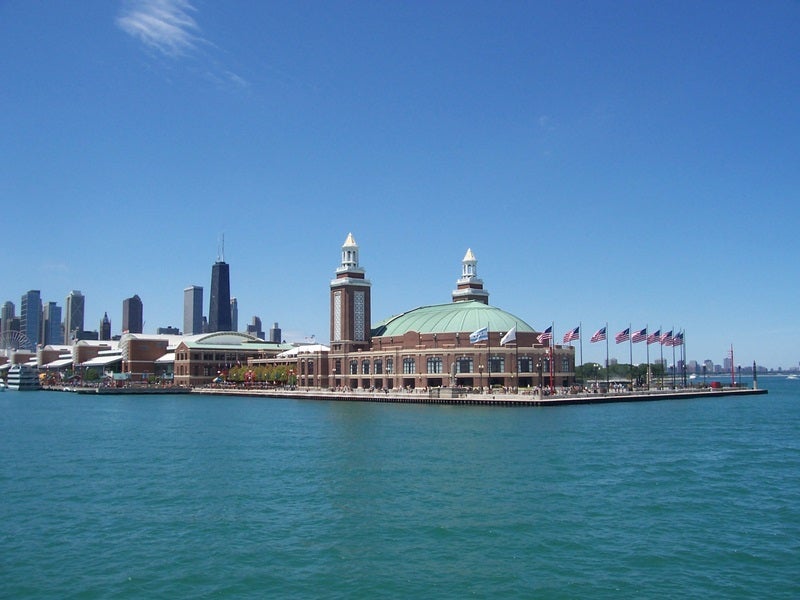
The Navy Pier and city skyline, seen from a tall ship cruise on Lake Michigan. The pier was built as part of Burnham’s 1909 Plan of Chicago and underwent a $200 million renovation in the 1990s.
We’re all adults here
But there was something else I noticed about Chicago that didn’t come to me until day 3 or 4 – and then, it was obvious. We saw plenty of kids in the multiple parks we visited (they were everywhere in Millennium Park), and even passed through several gaggles of teens here and there. The former were mostly with their parents, with many of them out-of-towners like us, on vacation. The latter were usually walking in groups, occasionally hustled along by beat cops trying to keep sidewalk foot traffic flowing in the denser spots.
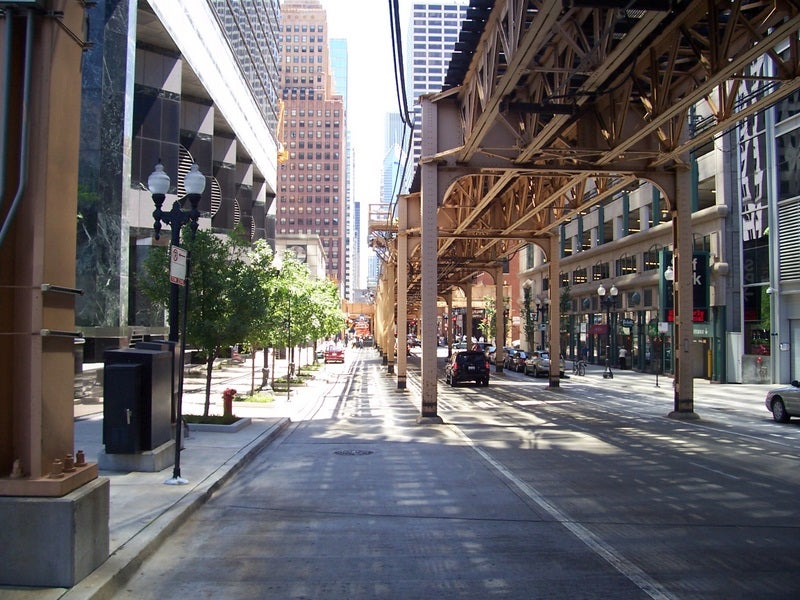
The El and the river.
Passing through the Loop on the El one day, we were stopped briefly as passengers boarded. Through the thick Plexiglas, My eye caught a small button just across the shaded platform. It read, “Press for heat.” I glanced above at piping that must provide individual showers of warmth for flash-frozen office workers on their way home in January. “That’s pretty nifty,” I muttered.
“This city,” my wife said, shaking her head. “This is a city for adults.”
Perhaps it was a had-to-be-there-moment, but it struck me as a sound, concise assessment. It’s a town where average citizens know what you mean when you talk about the Planning Department. Where, even on Monday nights in the summer, there is dancing in the park with a live band, free.
And on that dance floor in Millennium Park? A sight I’ll never forget. Dozens and dozens of couples, perhaps 150 in all, with at least that many on the surrounding grass apron, looking on. Young and old, in shirt-and-tie from offices, in pantsuits and skirts, in baggy shorts and t-shirts cut off to reveal naval piercings and tramp-stamps. Grandmoms in halter tops. Gay and straight. Black, white, Asian, Hispanic and in-between. Chinese and Mexicans (tourists and locals both) and a couple of Japanese that clung to the stereotype of a camera around their neck like a badge of honor. The band was a mix of Creole-reggae, and, leaning heavily on an expert zydeco vest frottoir player, tossed in some klezmer, just to kick it old-Europe-style for a few minutes.
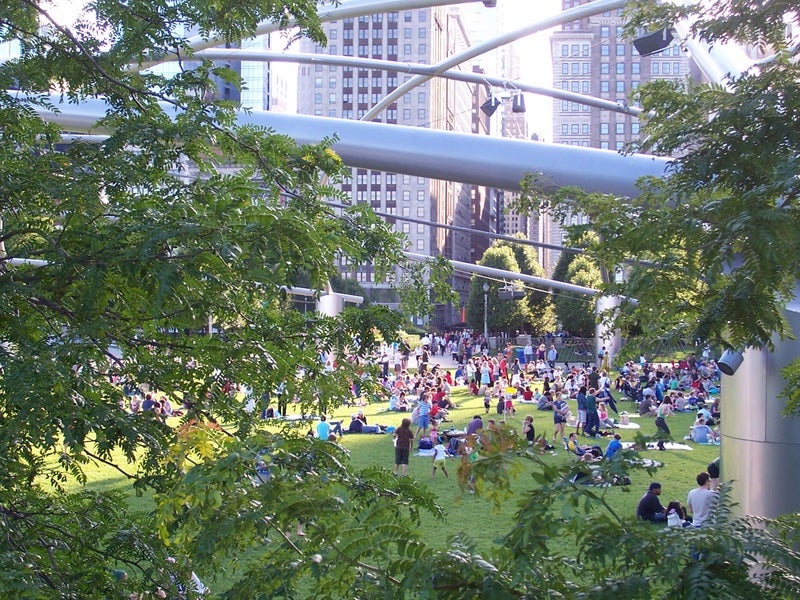
Part of the scene at the Pritzker on a Friday night.
I’ve been to tons of weddings, but I’ve never seen a dance floor with as many smiles. And I’ve been to my share of outdoor concerts, but never observed as many people actually dancing (Dead shows don’t really count).
The city-for-adults theme was evidenced at Wrigley, too. It’s not that there weren’t many kids there – this was a Sunday afternoon, after all. But Wrigley – its confines indeed as friendly as lore has it – doesn’t seem to brook constant back-and-forth from the seats to the concessions for ice cream, then cotton candy, then a souvenir, then nachos and a another Coke, etc. You can get all that stuff in the one main concourse, but it seemed like mostly hotdogs or bratwurst and a cup of Old Style (which is no Yuengling, but beats a Bud or a Miller Lite). People get in their seats and stay there, for the most part. Sure, there are plenty of beer runs, but they happen between innings, when they should.
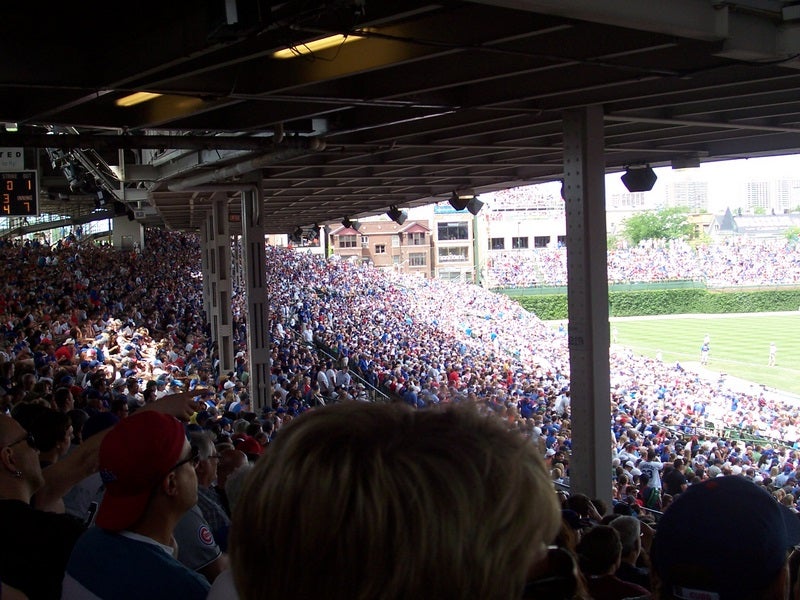
The friendly confines of Wrigley Field.
Also missing from Wrigley: constant, piped-in music. I’m not quite old enough to be very bothered by batters having their own theme songs, like they do at Citizens Bank Park (thus a snippet of Led Zeppelin’s “Kashmir” blasted four times a game, 80 times a year, when Chase Utley moves toward the batter’s box), but it’s just kind of dumb. At Wrigley, the only tunes came from an organist. A little respect. (And when the home team wins, the crowd sings. Boy do they sing.)
Again, all of these very positive vibes could have been due to the perfect weather. We’re fairly certain Chicagoans can be every bit as nasty as … oh, New Yorkers, for example. But despite the summer crowds, there was never a sense of being policed, no matter what the neighborhood, even well beyond the normal tourist spots.
Millennium Park
If you haven’t been to Chicago in a while, it’s worth a visit just to see this fantastic public space that is adjacent to the already enormous Grant Park (for 173 years, a.k.a. “Chicago’s Front Yard”), south of downtown between Michigan Avenue and the lake. The Frank Gehry outdoor amphitheater (the Jay Pritzker Pavilion) is mind-bogglingly beautiful, a public space so inviting that people throw down blankets and read on its expanse of lawn and play Frisbee and meditate – even when there is no show.
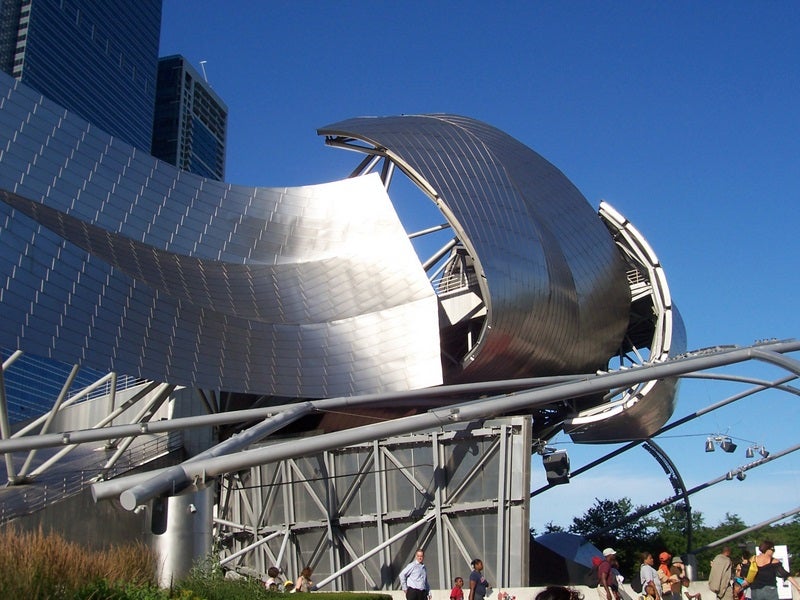
Gehry’s Pritzker Pavilion.
To call the Pritzker Pavilion a “band shell” is like calling the Philadelphia Museum of Art a place to hang paintings. Taking five years to construct (opening in 2004, most of Millennium Park was over-budget and a little late to mark the kickoff to the new millennium, but whatever), the Pritzker is the home of the Grant Park Symphony Orchestra and Chorus and the free Grant Park Music Festival. The distinct design is complimented by an overhead “trellis” – which again seems like an understatement, since the 22 lattice-like arches form a complicated sound system as well as a wondrous work of art in itself. With weatherproof speakers mounted everywhere, the sound is supposed to be carried up and over the great lawn in such a way that millisecond delays replicate concert hall acoustics. Sadly, I didn’t get chance to confirm this.
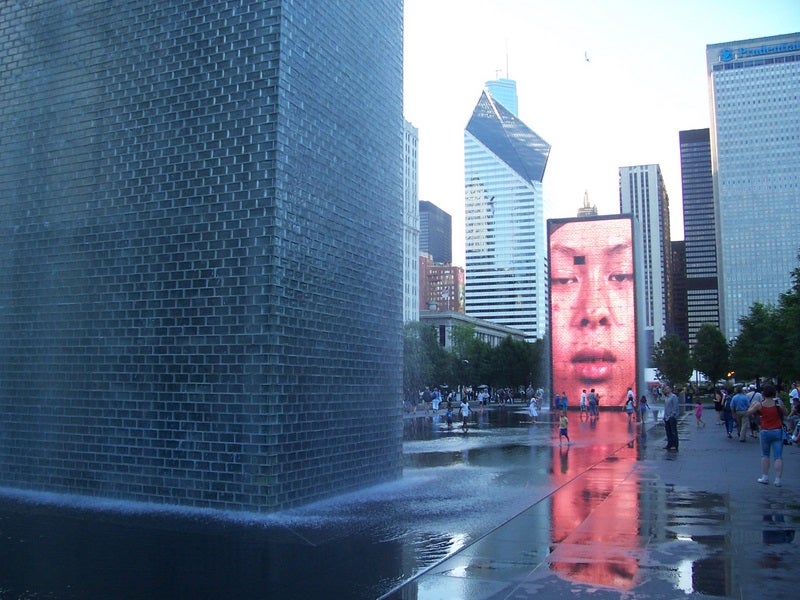
The Crown Fountain, Millennium Park
The interactive Crown Fountain by Jaume Plensa was built from black granite as the base of a reflecting pool that sits ankle-deep between two 50-foot glass-brick towers. The towers produce alternating cascades of water and hydrant-like blasts, at play with LED lights embedded in the brickwork that produces images as well as colors. Dozens of Chicagoans’ faces stare from each tower, facing each other, slowly changing expressions in a mesmerizing artistic work. Children delight in the pools of showers of water. Lovers meet in the middle of the pool, leaving their sandals in the care of onlookers. At dusk, photographers click from thousands of angles.
You can spends hours – a whole day or more, really – amid the contemporary Lurie Garden designed by the team of Kathryn Gustafson, Piet Oudolf and Robert Israel. A breathtaking footbridge designed by Gehry soundproofed the theater from the tranquil gardens.
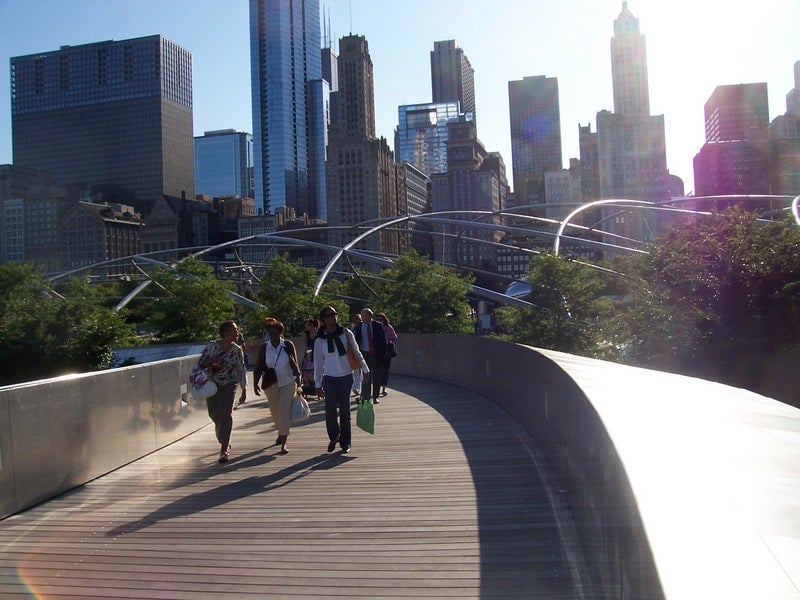
Gehry’s footbridge.
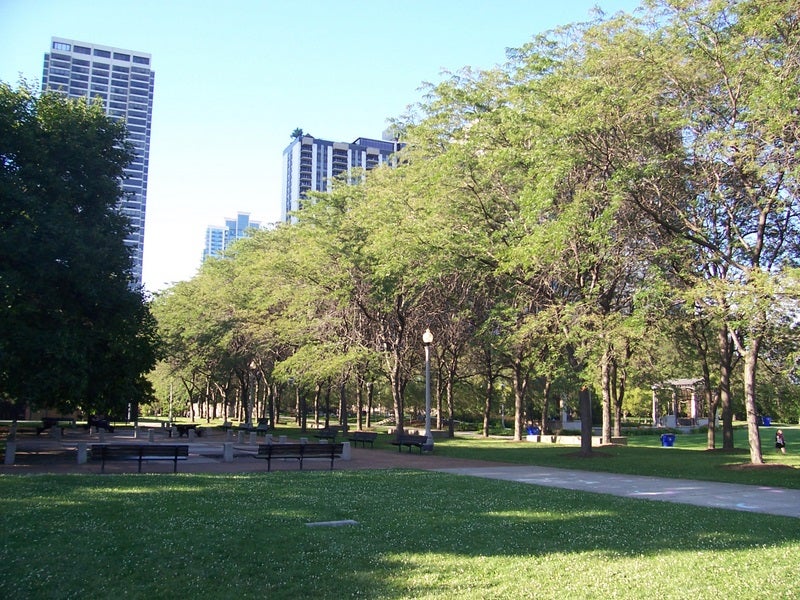
Lurie Garden.
As for the “Cloud Gate” sculpture by Anish Kapoor, photos don’t do it justice. As with the Crown Fountain and the grounds of the Pritzger, the main ingredient, judging by visitors’ reactions, is simply joy.
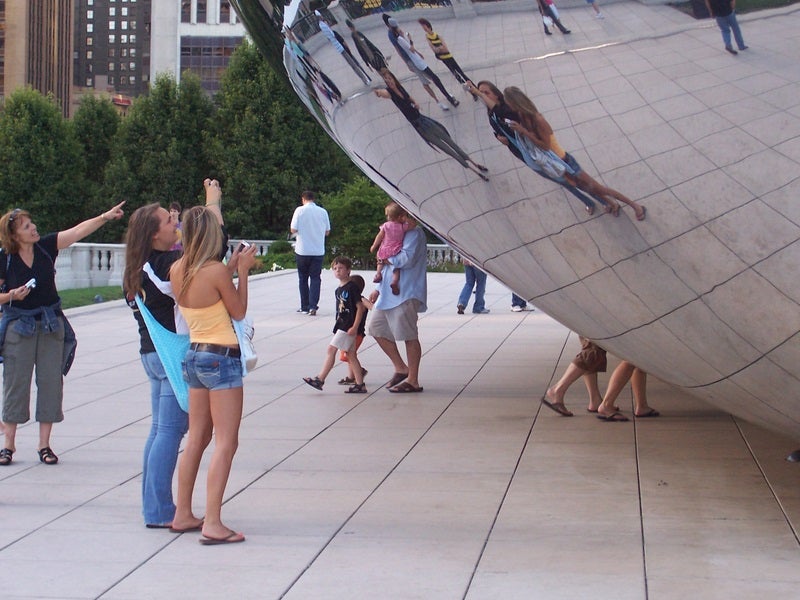
Cloud Gate.
Oak Park
An easy half-hour ride west from the Loop via the El lands you in Frank Lloyd Wright Land, or Oak Park., Ill., an upscale suburban town that is ground zero for fans of Wright’s stunning and varied collection of houses, along with the Unity Temple, a 100-year-old Unitarian church that he designed. (See slideshow, above, for Oak Park photos.)
Oak Park is also the birthplace of Ernest Hemingway, and his boyhood home is now a museum there. (It’s a lovely place, but frankly can’t hold a candle to his old Italianate crib in Key West, with its salt water swimming pool, collection of 20-plus six-toed cats and proximity to Sloppy Joe’s.)
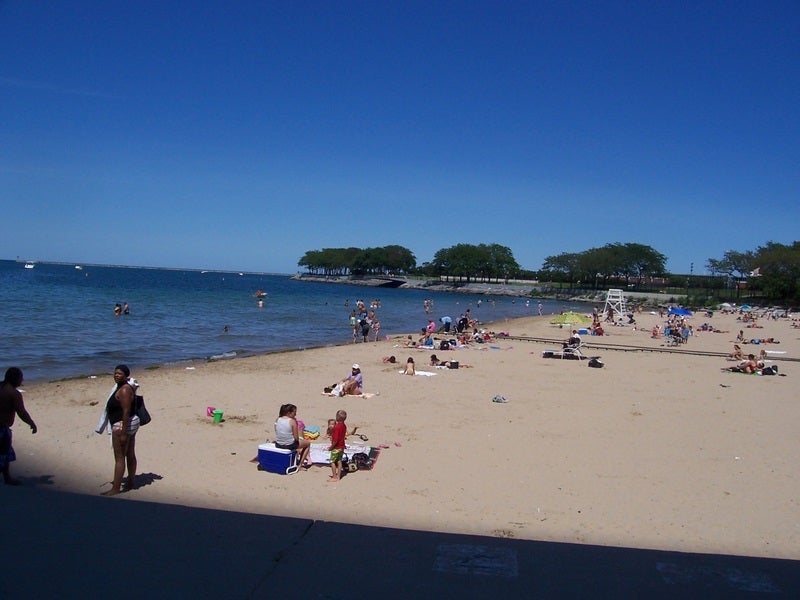
Oak Street Beach, Lake Michigan
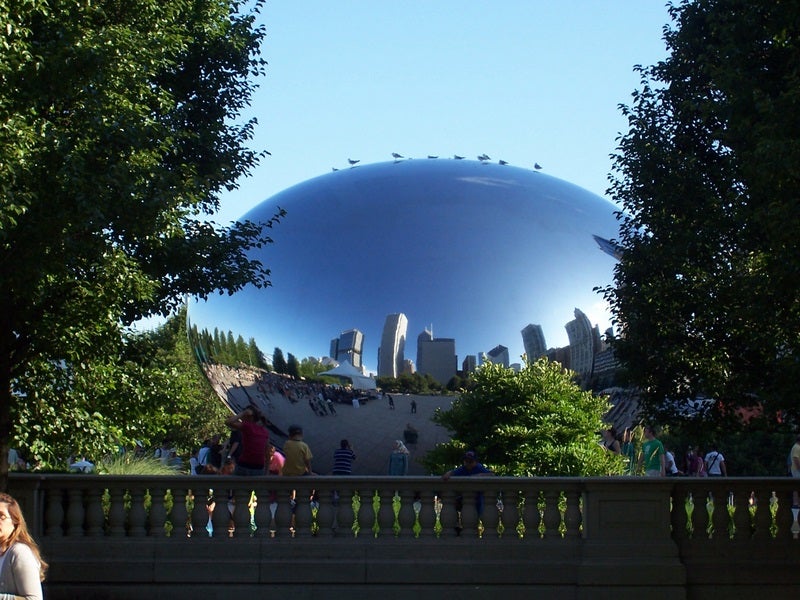
Birds on an egg (Cloud Gate)
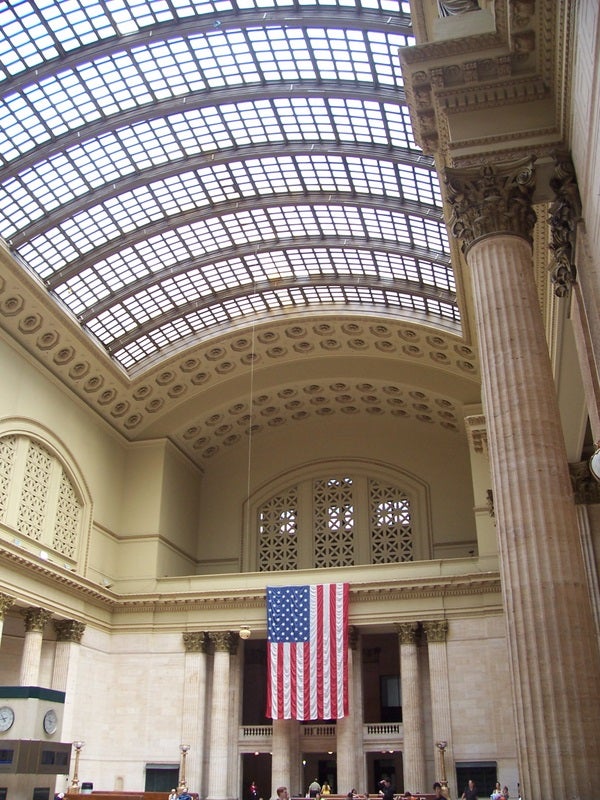
Union Station
Chicago blues
I mentioned the weather several times, but it was actually drizzling steadily when we arrived at Midway, and continued to do so for a few hours. At 11:45 a.m. on a Friday, we were too early to check into our hotel facing Grant Park. So we stowed our bags with the bell man and wandered down South Wabash Avenue in search of lunch.
We wandered into a blues bar after scanning what looked like decent seafood offerings on the wall outside. The place looked a little iffy, but to take a load off, we sat down at a table apart from the bar. A few minutes later, right at noon, a lean gent arrived on stage with a stool and a steel guitar that seemed to be part of his body, encased in leather arms and denim legs.
Sound check for later that night? I asked, since we were about 15 feet from him. “Nope,” he said, picking out a few notes. “It’s 12, man. First set of the day. And we’ve got an audience.”
“Yes, as a matter of fact, we would like some menus,” I told the waitress. “And please, take your time.”
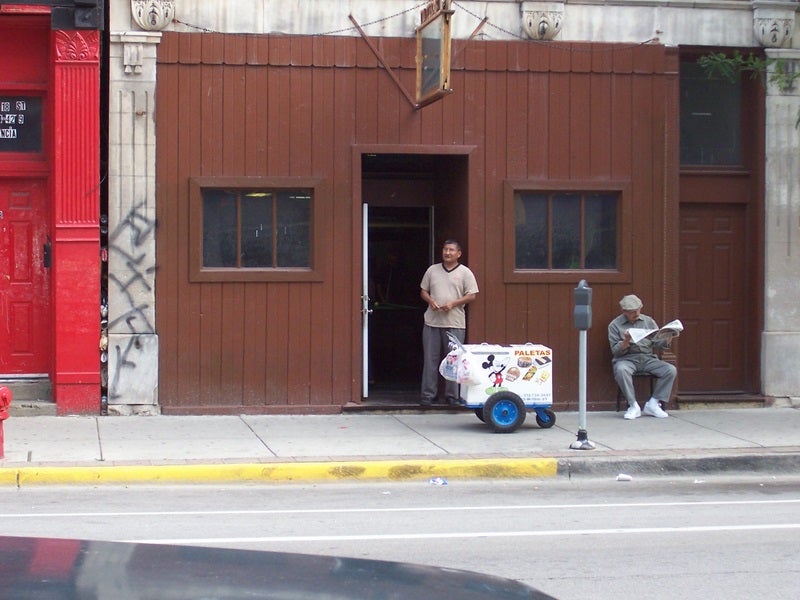
In the Mexican / Italian neighborhood, southwest of downtown.
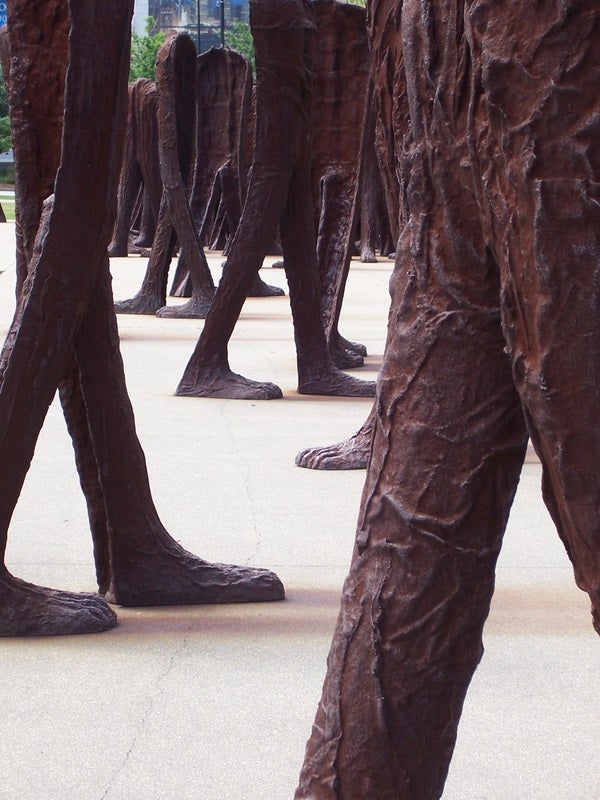
“Agora,” statuary art installation by Magdalena Abakanowicz, Grant Park.
Contact the reporter at www.ThomasJWalsh.info.

WHYY is your source for fact-based, in-depth journalism and information. As a nonprofit organization, we rely on financial support from readers like you. Please give today.



